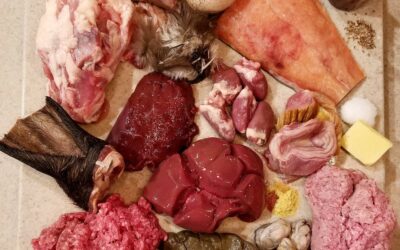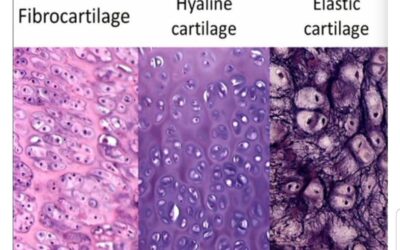Nutrients
Dogs require two macronutrients. Macronutrients contain calories and are required in large amounts for energy and metabolic function. These include proteins and fats. Dogs can also utilize carbohydrates which are the third macronutrient; however, research indicates that dogs have no need for carbohydrates. What that means is dogs do not require carbohydrates to either survive or thrive.
Protein:
Proteins are molecules made up of a chain of amino acids that are held together by peptide bonds. When a specified chain of amino acids is created it then folds into a three dimensional shape dependent upon its need and use in the body. To utilize dietary protein, a dog’s digestive system breaks the peptide bonds to release each individual amino acid. The individual amino acids are the building blocks of new protein molecules that the dog’s body creates as needed and puts it to use. Protein is needed for tissue growth and repair, to create cells, bones, cartilage, muscles, skin, blood, antibodies, enzymes, and hormones, plays a role in pH regulation, helps balance fluids, transports and stores nutrients, and can also be burned as an energy source. Protein is what is known as gluconeogenic. Because protein’s main function is to create new protein structures, it is not a main source for energy metabolism. However, it can be converted by the body into a carbon skeleton to be utilized and stored as energy in the absence of adequate fat intake or body fat percentage.
There are twenty-two amino acids along with taurine, an amino sulfonic acid. A dog’s body manufacturers all but ten amino acids. These ten are known as essential amino acids and include arginine, histidine, isoleucine, leucine, lysine, methionine, phenylalanine, threonine, tryptophan, and valine. These are called essentials because a dog must receive them from the diet. All prey, animal-sourced foods, and animal products contain all ten of these essential amino acids in varying amounts and profiles.
Fat:
Fats (lipids) are chain molecules ranging from short chains to long chains. The main functions of fat are energy metabolism, to spare protein from being utilized as an energy source, for the absorption and storage of fat-soluble vitamins, hormone production, and are needed as the structural material of cell membranes as well as aiding in the construction of other cellular components and various bodily tissues. The main constituents making up animal-origin fats are monoglycerides, diglycerides, and triglycerides, a chain (mono-) or chains (di- and tri-) of fatty acids bonded to a glycerol. Saturated fat, unsaturated fat, and polyunsaturated fat refer to the structure of the fatty acids. Fatty acids (a carboxylic acid) consist of hydrocarbon chains ending with a carboxyl group and are considered the building blocks of lipids.
What we are most concerned with in the canine diet is the fatty acids. Of the fatty acids, two types are essential and must be obtained from the diet: omega-3 and omega-6 fatty acids. These include the omega-6 fatty acids linoleic acid (LA) and arachidonic acid (AA)- AA can technically be converted from LA; and the omega-3 fatty acids alpha-linolenic acid (ALA), eicosapentaenoic acid (EPA)- EPA can technically be converted from ALA, and docosahexaenoic acid (DHA)- DHA can technically be converted from EPA. The omega-3 fatty acids function antagonistically with omega-6 fatty acids, so the correct balance between these fatty acids is necessary.
Carbohydrates:
Carbohydrates are non-essential plant sugars, starches, and fibers. Carbohydrates are short and long chains of saccharides known as mono-, di-, oligo-, and polysaccharides. They have one main function: energy metabolism. However, like fat, they spare protein from being converted to an energy source; they also act as food for the microbiome, bulking agents, and are useful for weight gain and energy storage. Carbohydrates are found in foods such as fruit, vegetables, grains, peas, and legumes.
Dogs also require micronutrients. Micronutrients are not a source of energy and are needed in very small amounts. They are vital to life and for the optimal functioning of the canine’s entire biology. The micronutrients that we know of to date are vitamins and minerals.
Vitamins:
Vitamins are organic compounds that contain carbon and hydrogen bonds. Essential vitamins cannot be synthesized by the body and must be received from the diet. Deficiencies in vitamins often lead to pathologies that can be deadly. There are two types of vitamins: fat-soluble and water-soluble. The fat-soluble vitamins A, D, E, and K require fat for absorption and can be stored in the liver and fat tissues of the body. The water-soluble vitamin complexes B and C along with bioflavonoids are found in the juicy or watery parts of foods and are absorbed directly into the bloodstream during digestion where they are carried to the tissues to be utilized. Because of the high concentration of water in the body, water-soluble vitamins easily circulate throughout the body and are excreted in the urine.
Essential fat-soluble vitamins:
- Vitamin A: retinol, alpha-carotene, beta-carotene, beta-cryptoxanthin
- Vitamin D: cholecalciferol (D3), calciferol (D2)
- Vitamin E: alpha-tocopherol, beta-tocopherol, gamma-tocopherol, delta-tocopherol, alpha-tocotrienol, beta-tocotrienol, gamma-tocotrienol, delta-tocotrienol
- Vitamin K: menaquinone (K2), phylloquinone (K1)
Essential water-soluble vitamins:
- B Complex:
- Thiamine (B1)
- Riboflavin (B2)
- Niacin (B3)
- Pantothenic acid (B5)
- Pyridoxine (B6)
- Cobalamin (B12)
- Biotin (B8)
- Folate (B9)
- Choline
- Vitamin C: P factor, J factor, tyrosinase
- Bioflavonoids: proanthocyanidins, quercetin, rutin, quercitrin, hesperidin, naringin
Minerals:
Minerals are inorganic compounds that originate in the soil and sea. They contain no carbon and hydrogen bonds. Biological systems cannot synthesize minerals, nor can they directly utilize mineral salts from the earth or sea. Rather, minerals are absorbed by the roots of plants and following various metabolic processes, the absorbed minerals become complexed with carbohydrates, fats, and proteins within the plants. Nutritionally, dogs eat the animals which eat the plants which contain the complexed minerals and from this our canines receive the essential minerals they require for life.
There are two types of minerals: macro-minerals and trace minerals.
Macro-minerals are required in much larger amounts than trace minerals. The macro-minerals that dogs must obtain from their diet include:
- calcium
- phosphorus
- sodium
- potassium
- magnesium
- sulfur
- chloride
The trace minerals, which needed in tiny amounts, include:
- copper
- iron
- manganese
- zinc
- iodine
- selenium
- cobalt
- chromium
There is a significant problem with the way we view vitamins and minerals. The difficulty and error pertains to science considering and examining nutrients separated and isolated from their food sources. Scientific study and findings are then published and circulated where information is propagated and marketed for capitalization. As a result, the last eight decades has mass produced laboratory created nutrient counterfeits that are sold to the processed food industry (human and animal feed) to fortify every conceivable food and to the general public in pill, capsule, tablet, liquid, and powder form for private use and as a “health” insurance strategy. Society has been misled to believe that isolates function independently as distinct constituents apart from the whole. Even pet parents who have taken their pet’s health seriously and are providing homemade raw meals are adding bottled nutrients as a hypothetical insurance policy to “cover all the bases” and thereby removing any fear and concern that their pets are missing essential nutrients. From where does this error in understanding originate? It is first necessary to recognized that it is never the fault of nature for man’s erroneous assumptions, but man’s inability to see and comprehend the whole picture. With that, I would like to take you back to the 18th century.
Beginning with the early date of 1747, a Scottish naval surgeon named James Lind made an amazing discovery. He understood that a then-unknown substance found in lemons, limes, and several other fruits and vegetables prevented the serious and life-threatening disease condition afflicting sailors known as scurvy. This unknown substance came to be known as vitamin C. In 1905, Englishman William Fletcher hypothesized and then discovered that specific constituents within foods prevented a disease state while their removal would lead to pathologies. Sir Frederick Gowland Hopkins, an English biochemist in 1906 understood that certain food factors were vital for the growth of the body. His discoveries were proteins, carbohydrates, fats, and minerals. Polish scientist Cashmir Funk, in 1912, gave a name to these newly discovered nutritional components of food. He called them a “vitamine.” “Vita” means life while “amine” came from the compounds of thiamine (Vitamin B1) which he discovered in rice husks and then isolated. Vitamine was later shortened to vitamin, what we now know them as today. These discoveries gave credence and functional purpose to the consumption of specific foods for the benefit of growth, health, and disease prevention. However, these discoveries also encouraged the scientific community to interfere with what nature provides in her trustworthy, reliable, flawless, and unfailing perfection. As early as the 1930s, scientists had already discovered how to create synthetic versions of nutrients. The fortifying of grain products, dairy foods, and desserts with their synthetic imitations was in full force. Health food stores began to pop up in the 1940s as the newest trend in capitalizing on the sales of synthetic vitamins and isolates. The stores and products gained in popularity by the 1950s. Soon more and more food constituents were being discovered and isolated including antioxidants and coenzyme Q10. Today health food stores can be found just about everywhere in the world while supplements are common household items and necessities. There is no doubt that these early discoveries and scientific studies were immensely valuable. They allowed mankind to understand the roles and functions of the individual nutrients. However, and this is a big however, as with all early discovery of the new and unknown, incorrect assumptions and conclusions are often made. We know this to be true by the countless times science has warned us against eating certain foods, or vise verse telling us to load up on this food or that, scaring the public with speculative warnings, telling us to do such as such, and so on and on. Alarmingly, years later we are informed that what we thought and believed was correct and true has now been proven to be completely erroneous. As for the topic at hand, synthetic nutrient supplements and isolates were wrongly and incorrectly assumed to be just as effective and health-promoting as natural whole-food sources of nutrients. This erroneous assumption is still believed by a good number of nutritionists and nutritional scientists. How do we now know the truth? Enter quantum physics.
Quantum physics is the study of the nature and behavior of matter and energy on the atomic and subatomic level. It is the theoretical basis of modern physics. How possibly does this relate to homemade raw feeding? Stay with me! Quantum physics has demonstrated not only the existence of, but the multitude of cofactors and enzymes that exist within and around the vital nutritional nutrient structures (vitamins and minerals) that are absolutely essential for adequate absorption and the correct functioning within a biological system. It is understood that the cofactors are just as vital as each nutrient itself. While the body produces enzymes (protein structures), enzymes are also dietary needs and are received through raw foods. Enzymes are catalysts for chemical reactions, each enzyme being specific for each substrate such as enzymes for the breakdown of fatty acids and enzymes for energy production. Cofactors are essential and required for the chemical reactions between the enzymes and substrates while other cofactors increase the rate of catalysis. Cofactors are either attached or loosely bound to enzymes. The body is unable to manufacture all the necessary cofactors so it must receive them through whole foods. Thus science is now beginning to understand why synthetic and nutrient isolates do not and cannot perform nor function in the same manner as naturally occurring food nutrients.
Minerals in supplement form are problematic on a different scale. There is a major difference between naturally occurring food sourced minerals and supplemental minerals. Within the book entitled Handbook of Drug-Nutrient Interactions we read, “The chemical form of a mineral is an important factor in its absorption and bioavailability…there is evidence that the form in which minerals are ingested affects absorption. For example, particle size, surface area, and solubility of a substance affects is dilution rate…In many solid foods, elements are not free, but firmly bound in the food matrix1.” We learn that food source minerals are firmly bound with cofactors within the food matrix. Mineral supplements are mostly industrially processed inorganic rock known as mineral salts. As already stated, biological systems cannot synthesize minerals, nor can they directly utilize mineral salts from the earth or sea. Rather, minerals are absorbed by the roots of plants and following various metabolic processes, the absorbed minerals become complexed with carbohydrates, fats, and proteins within the plants. The only way that we and our pets can adequately receive bioavailable (absorbable) minerals is through the consumption of plants or the animals that ate the plants. Mineral salts in a bottle can be labeled “natural” because they are in fact found in the earth. But neither humans nor our dogs are plants which can utilize earth and sea minerals. And because scientists now recognize this fact, many supplemental minerals are chelated, yet still inorganic. Inorganic chelation is the process of chemically binding crushed industrial rock with one or more acids. You will see these types of mineral supplements labeled with one of the following acids: ascorbate, picolinate, aspartate, glycinate, and chelate. The mineral now takes on a different form from the mineral salts; however, it is still not a food. While these can certainly be absorbed with the chelate, they are not necessarily as effective as food sourced minerals or even safe. For example, picolinic acid, such as zinc picolinate and chromium picolinate supplements, is used in herbicides, it is an excretory waste product, and is not metabolized by or useful to the body. These create oxidative stress which can potentially lead to damaged DNA.
It has been clearly demonstrated in test studies that the bioavailability and effectiveness of food source minerals is greater than that of isolated inorganic mineral salts and chelates. Mineral absorption is low to begin with such as iron absorption being potentially as low as 5%. Taking supplemental minerals can have a useable absorption percentage of 0% to 1%. Even more, food sources of minerals are almost never toxic and may actually have protective factors that prevent mineral toxicities. Because absorption of actual utilizable (organic) minerals is much different, supplemental forms that are chemically bound to another substance function differently hence causing the potential for toxicity. The following list shows a few popular industrial inorganic mineral chemicals sold as supplements:
- Calcium carbonate (limestone, chalk)
- Calcium citrate (calcium carbonate processed with lactic and citric acid
- Calcium gluconate (calcium carbonate processed with gluconic acid)
- Calcium lactate (calcium carbonate processed with lactic acid)
- Chromium picolinate (picolinic acid)
- Magnesium carbonate (magnesite rock)
- Magnesium citrate (acids)
- Magnesium chloride (ammonium chloride)
- Magnesium glycinate (glycine)
- Magnesium oxide (burnt magnesium carbonate)
- Magnesium carbonate
- Magnesium gluconate (magnesium carbonate with gluconic acid)
- Magnesium sulfate (chemical reaction between magnesium oxide and sulfuric acid)
- Potassium chloride (chlorine)
- Potassium citrate (citric acid)
- Potassium gluconate (gluconic acid)
- Zinc gluconate (gluconic acid)
- Zinc picolinate (picolinic acid)
- Zinc sulfate (sulfuric acid)
One of my favorite doctors, Bernard Jensen, wrote nearly four decades ago in his book The Chemistry of Man, “When we take out from foods some certain salt, we are likely to alter the chemicals in those foods. When extracted from food, that certain chemical salt is extracted, may even become a poison. Potash by itself is a poison, whether it comes from a food or from the drugstore. This is also the case with phosphorus. You thereby overtax your system, and your functions must work harder, in order to throw off those inorganic salts or poisons introduced…The chemical elements that build our body must be in biochemical, life-producing form. They must come to us as food, magnetically, electrically alive, grown from the dust of the earth.2” This applies equally to our animals. The following chart3 shows the absorption and bioavailability of natural food source mineral compared to inorganic mineral supplements.
| Food Mineral | Compared to Mineral Salt/Chelate | |
| Calcium | Up to 8.79 times better absorbed into the blood; 7 times as effective in raising serum ionic calcium levels. | |
| Chromium | Up to 25 times more bioavailable. | |
| Copper | 85% more absorbed; also contains substances that reduce potential toxicity. | |
| Iron | Safer, non-constipating, 77% more absorbed. | |
| Magnesium | Up to 2.2 times better absorbed and retained. | |
| Manganese | Better absorbed and retained; not as likely to contribute to toxicity as mined forms. | |
| Molybdenum | Up 6.28 times better absorbed into the blood; 16.49 times better retained. | |
| Phosphorus | Less likely to cause diarrhea or electrolyte disorders. | |
| Selenium | 17.6 times the antioxidant effect; 123.01 times more effective in preventing non-enzymatic protein glycation; 2.26 times better retained. | |
| Vanadium | Safer and 50% more effective. | |
| Zinc | Up to 6.46 times better absorbed, better and safer form |
©2019 Kimberly Lloyd, PhD, BCHHP, Cert Raw Dog Food Nutritionist
1 Shapes SA, Schlussel YR, Cifuentes M, chapter “Drug-Nutrient Interactions That Affect Mineral Status” from the book entitled Handbook of Drug-Nutrient Interactions. Humana Press, Totowa (NJ), 2004: 301-328
2 Bernard Jensen, DC, PhD, The Chemistry of Man. Escondido (CA), 1983
3 Robert Thiel, PhD, Naturopath, The Truth About Minerals in Nutritional Supplements, Doctors’ Research™ website, http://www.doctorsresearch.com/articles3.html



